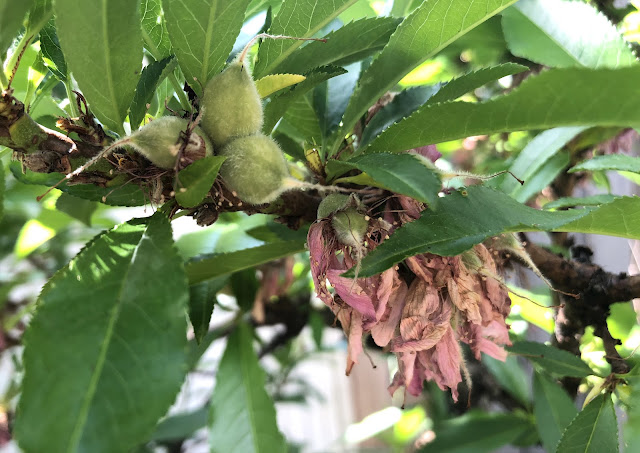
First 90-degree days of 2022 expected soon

|
|
Fruit trees are setting fruit and would appreciate a good soak before temperatures
pop into the 90s later this week. (Photo: Kathy Morrison)
|
Early April will feel more like late May as near-record heat is on the way. Sacramento could see 90 degrees by next weekend.
According to the National Weather Service, “We are going to see an extended period of quiet weather with a big warmup in store for the mid to end of next week. Some locations could see their first 90 degree-plus (high) of the year.”
Sacramento starts out warm. After expected 80-degree highs this weekend, cloud cover will cool temperatures slightly; 77 degrees is the Monday-Tuesday forecast. But then the heat really spikes, with 92 degrees forecast for Thursday and Friday. Both highs would be records for those dates – and 20 degrees above normal. Sacramento averages 71 degrees in April; our all-time hottest April day was 96 degrees.
Meanwhile, our overnight lows will stay relatively normal, in the mid to high 40s. Sacramento’s average low for April is 46 degrees.
After a bone-dry January and February, this warm spring weather has affected the Sierra snow pack – bad news for us Valley water users. Released Friday, the totals were bleak.
“Unfortunately, the new snow pack numbers are not an April fools joke,” tweeted the NWS Sacramento office. “@CA_DWR (California Department of Water Resources) measured only 4% of average for the Phillips Station today with the statewide percent of average at 38%.”
That means water restrictions will almost certainly go into effect at some point this year, likely sooner than later. Keep that in mind while planting your summer garden.
Is it warm enough to plant tomatoes? It might be too hot this week with those 90s in the forecast. On the other hand, that heat might finally warm up the soil enough to transplant summer vegetables. Raised beds and container gardens warm more rapidly than flat ground.
Just make sure to keep seedlings and new transplants hydrated. Before those 90-degree days arrive, deep-water trees and shrubs.
Other tasks for your garden to-do list:
* April is the last chance to plant citrus trees such as dwarf orange, lemon and kumquat. These trees also look good in landscaping and provide fresh fruit in winter.
* Feed shrubs and trees with a slow-release fertilizer. Or mulch with a 1-inch layer of aged compost.
* Azaleas and camellias looking a little yellow? If leaves are turning yellow between the veins, give them a boost with chelated iron.
* Trim dead flowers but not leaves from spring-flowering bulbs such as daffodils and tulips. Those leaves gather energy to create next year's flowers. Also, give the bulbs a fertilizer boost after bloom.
* Pinch chrysanthemums back to 12 inches for fall flowers. Cut old stems to the ground.
* Feed citrus with a low dose of balanced fertilizer during this month’s bloom and fruit set.
* Mulch around plants to conserve moisture and control weeds.
* From seed, plant beans, beets, carrots, celery, chard, fennel, radishes, seed potatoes, spinach and squash.
* Plant onion sets.
* In the flower garden, plant seeds for asters, cosmos, celosia, marigolds, salvia, sunflowers and zinnias.
* Transplant petunias, zinnias, geraniums and other summer bloomers.
* Plant perennials and dahlia tubers for summer bloom.
* Plant summer bulbs, such as gladiolus and tuberous begonias.
Comments
0 comments have been posted.Sacramento Digs Gardening to your inbox.
Sites We Like
Garden Checklist for week of May 5
Survey your garden after the May 4 rainstorm. Heavy rain and gusty winds can break the neck of large flowers such as roses. Also:
* Keep an eye on new transplants or seedlings; they could take a pounding from the rain.
* Watch out for powdery mildew. Warmth following moist conditions can cause this fungal disease to “bloom,” too. If you see a leaf that looks like it’s dusted with powdered sugar, snip it off.
* After the storm, start setting out tomato transplants, but wait on the peppers and eggplants (they want warmer nights). Pinch off any flowers on new transplants to make them concentrate on establishing roots instead of setting premature fruit.
* Trim dead flowers but not leaves from spring-flowering bulbs such as daffodils and tulips. Those leaves gather energy to create next year's flowers. Also, give the bulbs a fertilizer boost after bloom.
* Pinch chrysanthemums back to 12 inches for fall flowers. Cut old stems to the ground.
* Mulch around plants to conserve moisture and control weeds.
* From seed, plant beans, beets, cantaloupes, carrots, corn, cucumbers, melons, pumpkins, radishes and squash.
* Plant onion sets.
* In the flower garden, plant seeds for asters, cosmos, celosia, marigolds, salvia, sunflowers and zinnias. Transplant petunias, zinnias, geraniums and other summer bloomers.
* Plant perennials and dahlia tubers for summer bloom.
* Don’t wait; plant summer bulbs, such as gladiolus and tuberous begonias.
* Harvest cabbage, lettuce, peas and green onions.